Pneumatic valve actuation
The characteristic and universally used mushroom or "poppet" valves (used in every 4-stroke engine) will open during their down-stroke and close during their up-stroke, until they make contact with their seats in the cylinder head.
Normally, the valve is operated by a "cam" system, which controls valve opening (down-stroke), while the valve "return", i.e. the closing movement (up-stroke) is the result of the action of a some kind of spring.
Valve float is an adverse condition which occurs when the poppet valves on an internal combustion engine valvetrain do not remain in contact with the camshaft lobe during the valve closure phase of the cam lobe profile. This reduces engine efficiency and performance and potentially increases engine emissions.
Valve bounce is a related condition where the valve does not stay seated, due to the combined effects of the valve's inertia and resonance effects of metallic valve springs that effectively reduce the closing force, and allow the valve to re-open partially.
Renault has been a long-time influence in Formula 1. The first event considered to be a "Grand Prix" race, held at Le Mans in 1906, was won by a Renault.
In the modern era, their presence hasn't been as consistent as Ferrari, Williams or McLaren, but it has been considerable. They ushered in the Turbo Era of the 80's, taking advantage of a clause that allowed for smaller, turbo charged engines. The rest of the manufacturers thought they were nuts, but within a couple seasons every engine on the grid was turbo charged. Eventually the turbos had to be banned because the engines were just too fast, producing over 1200 horse power douring the race and Porshe engine 1500 Hp douring qualifications.
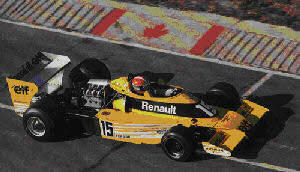 Racing engines often failed at high RPM-s because mechanical springs were unable to close valves fast enough, leading to engine failure when pistons struck incompletely closed valves. For this reason as many as three concentric valve springs, press fit into each other, were often used, not for more force (the inner ones having no significant spring constant), but to act as snubbers to reduce oscillations in the outer spring.
Racing engines often failed at high RPM-s because mechanical springs were unable to close valves fast enough, leading to engine failure when pistons struck incompletely closed valves. For this reason as many as three concentric valve springs, press fit into each other, were often used, not for more force (the inner ones having no significant spring constant), but to act as snubbers to reduce oscillations in the outer spring.
Stiffer valve springs can help prevent valve float and valve bounce, but only at the expense of increased friction losses. In Formula One, various techniques have been used to offset the effect of stiffer springs, such as dual-spring and progressive-sprung valves, roller-tipped tappets, and on the end, pneumatic valves.
If in a racing application a normal valve spring engine had an upper rpm limit of about 10,000 rpm, that same engine design when equipped with a Desmodromic valve actuation system would be capable of 15,000 rpm, and much more power. With pneumatic system there is practiclay no limit (actualy is around 25.000 RPM-s). Previously used wire valve springs use a coil spring to return the valve to a closed position after the cam has retarded. They required huge amounts of the detail development on their shape and material to reach the rev limits of around 12 - 13.000 RPM. The pressure to deliver power from 3.5 and later 3.0 engines required ever higher rev ceilings and metal springs could not longer be developed at the same rate as the rest of the engine.
Pneumatic valve springs are metal bellows filled with compressed air occupying roughly the same space of metal springs used to close valves in high-speed internal combustion engines. This system was introduced in the mid-1980s in Renault turbocharged RVS-9 1.5 litre Formula 1 engines. Renault's innovation was to replace steel springs with light weight compressed air bellows that could respond more quickly and reduce the possibility of valve crashes, other than from leaking bellows.
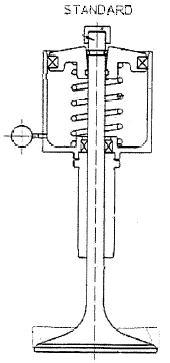
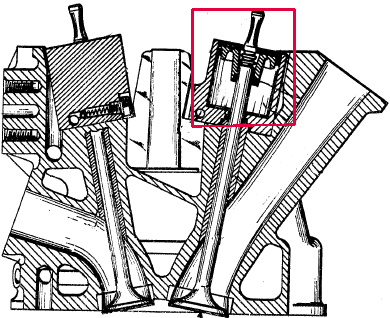
Standard spring and Renault pneumatic valve actuation in open view. In picture above, you can see that spring is missing.
Pneumatic valve springs gave Renault an advantage with its turbocharged engines, often said to be the most powerful. However, reliability and poor handling of their chassis kept the cars from success until 1989 when Renault provided Williams with its V10 engine to begin a winning streak. Renault returned to F1 in the 90's as an engine supplier. They again used the pneumatic valve closure system. This was quickly adopted by every engine manufacturer in F1. The new Renault engine was competitive right from the workshop. Renault won the constructors' championship with Williams in 1992, 1993, 1994, 1996 and 1997, and with Benetton in 1995. Nigel Mansell, Alain Prost, Michael Schumacher, Damon Hill and Jacques Villeneuve each won a Driver's championship in the 1990s with Renault engines.
The technology of all the current pneumatic valve return systems is that of simply replacing the valve spring with a pneumatic spring, using an inert gas (nitrogen, which behaves substantially the same as air, BUT IS INERT GAS AND DO NOT SUPORT THE FIRE AS AIR OR OXIGEN DOES) as the compressive fluid. The camshaft exercises its normal precise control of the motion of each valve, and each pneumatic spring maintains the contact force between an individual valve assembly, cam and tappet bucket, during operation. Pneumatic valve spring systems are thus an improved replacement for mechanical springs. They are not a complete valve control system like a desmodromic operation - which uses no springs.
 Pneumatic valve springs operate on a ring-main system with the essential back-up of a compressed gas cylinder, pressure regulators, one-way valves and an oil scavenging system. The principle reduction in valve assembly mass is that of the upper one-third of each valve spring. Although a nett small reduction in valve assembly mass is possible, this is accompanied by added friction of the stem seal ring.
Pneumatic valve springs operate on a ring-main system with the essential back-up of a compressed gas cylinder, pressure regulators, one-way valves and an oil scavenging system. The principle reduction in valve assembly mass is that of the upper one-third of each valve spring. Although a nett small reduction in valve assembly mass is possible, this is accompanied by added friction of the stem seal ring.
The pneumatic spring is not subject to fatigue failure, or diminished damping, with running time like mechanical spring is. Valve lift is not constrained by spring wire maximum stress and stress range limits. Renault reports that the rising rate characteristics of the pneumatic spring assists in matching spring force to valve assembly inertia force requirements in the particular case of its V10. The fundamental pneumatic spring advantage for very high speed engines is that the natural frequency of the compressed gas column is in the order of eight times that of a steel wire coil spring.
It was Jean-Pierre Boudy, the Chief Engineer of Engine Development at Renault Sport during the turbocharged V6 race engine era, who invented the first pneumatic valve spring system to be used in a competitive racecar engines. The pneumatic spring equipped Renault engine was first raced, in a Lotus chassis driven by Johnny Dumfries and Airton Sena 1986, at the beginning of the GP season.
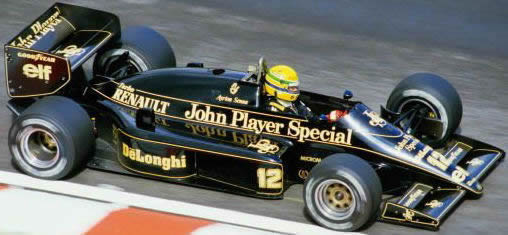
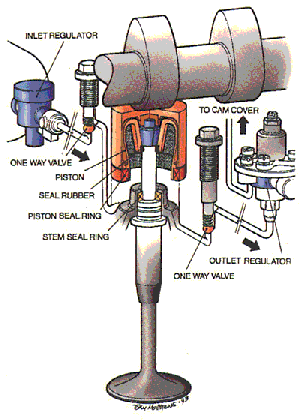
The Honda RA122E/B (1992 V12 F1) ran with nitrogen pressure at 6-8 bar (87-116 psi) with the gas replenishment cylinder charged, initially, to approx 150 bar (2175 psi). Honda claimed a reduction of valve assembly reciprocating mass of 20 % with similar levels of valve gear friction (as compared to conventional systems).

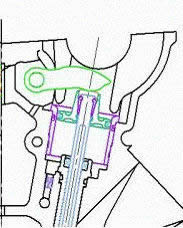
Pneumatic valve control became so compact and reliable that MotoGP motor racing start to use it. Well, all except Ducati with his desmodromic valve actuation. Pneumatic valve springs debut was in 2002 with the Aprilia RS3 Cube. In 2005, Team Roberts was the first to use pneumatic valves full time in their uncompetitive KTM powered bike. Today, almost all of the MotoGP teams use pneumatic valve technology on their bikes, including Yamaha, Suzuki and Honda.
Here on the picture left you can see valve actuation with pneumatic "spring" on Yamaha YZR M1 MotoGP engine during 2011 season.
While pneumatic valve springs have become standard in Formula 1 engines, Renault has been researching computer controlled electro hydraulic valves using no camshaft, to reduce moving parts while improving valve control. Pressure in upper part of valve piston (24) is controled with electroactuated selenoid valve (EVA). In this way is possible to controle exsact time of valve opening. Oil for actuating valve movement is contained in pressurised tank (32).
Lover part of piston is under constant pressure to ensure fast closing of the valve. Pressure is contained in separate pressurised tank (40).
Because this sistem have variable valve timing posibilities, it was never used in F1. FIA Technical rules consider variable valve timing as ilegal.

5.7 Variable geometry systems :
5.7.1 Variable geometry inlet systems are not permitted.
5.7.2 Variable geometry exhaust systems are not permitted.
5.7.3 Variable valve timing and variable valve lift systems are not permitted.5.10 Engine actuators :
With the following exceptions hydraulic, pneumatic or electronic actuation is forbidden :
a) Electronic solenoids uniquely for the control of engine fluids ;
b) Components providing controlled pressure air for a pneumatic valve system ;
c) A single actuator to operate the throttle system of the engine ;
d) Any components required as part of a KERS.5.15.6 Valves must be manufactured from alloys based on Iron, Nickel, Cobalt or Titanium.
Hollow structures cooled by sodium, lithium or similar are permitted.






